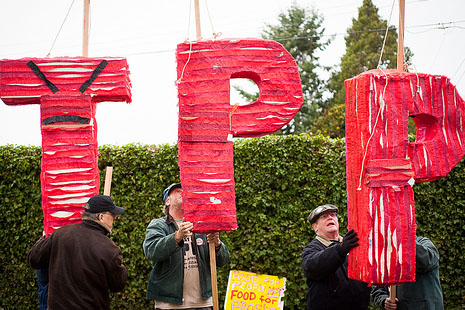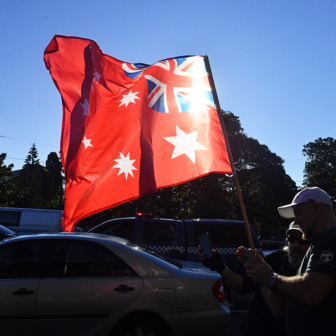WHEN WikiLeaks published the August 2013 draft of the Trans-Pacific Partnership Agreement’s chapter on intellectual property earlier this month, it was the first time anyone outside an inner sanctum of negotiators had seen any of the text since a previous leak in early 2011 (except, it seems, for corporate lobbyists). The TPP negotiations continued over the intervening two-and-a-half years, but so too did legislative action in the countries involved. The latest leak reveals inconsistencies between the draft text and trends in national law-making, and highlights a mixed performance by Australia’s negotiating team.
The period of copyright protection for creative works is one of the contentious issues facing the negotiators. In the current draft, copyright for individual writers, artists, composers and performers extends to seventy years after their death – largely the same as the proposal revealed in the previous leak, which matches domestic American law. For companies and other entities that create copyright content, the United States still proposes ninety-five years from the first authorised publication or performance and, if such a publication didn’t take place within twenty-five years of creation, 120 years from when the work or performance was created. These provisions are contested by other parties to the negotiations.
In Australia, the term of copyright protection has been the life of the author plus seventy years since 2006 (and even that goes beyond the life-plus-fifty-years of the Berne Convention). An alternative proposal from a majority of parties would set copyright periods in accordance with domestic law and with any international treaties, such as the Berne Convention, to which a particular country is a party. For most countries, this would result in shorter terms than the US proposal. The United States and Australia are among the four countries opposing this option.
The leaked chapter also suggests that storing material temporarily in electronic form could infringe copyright, although this is also highly contested by the parties. Indeed, some negotiators have proposed limitations and exceptions, to take account, for example, of material that is “transient or incidental and an integral and essential part of a technological process.” Otherwise, such a provision would seem to interfere with the normal functioning of web browsers making cache copies of pages. When this issue came up before the UK Supreme Court recently, it decided that temporarily stored web pages containing copyright material were not an infringement of these rights. If they were, said the court, millions of ordinary people would be infringing copyright every time they browsed the web, which would be an “unacceptable result.”
The text on parallel imports of copyright material remains the same as in the previous leak. Rights-holders shall have the right to prohibit the importation of copies of the work made without authorisation. But some parties, including Australia, argue that rights-holders shouldn’t be able to take the extra step of prohibiting imports of authorised copies made outside the territory – a proposal from the United States that contradicts a judgement of its own Supreme Court. Taking this extra step would be significant for Australia, given that a House of Representatives inquiry into IT pricing recommended earlier this year that any restrictions on parallel importation in Australian copyright law should be lifted.
UNLIKE the United States, Australia also supports another majority proposal that would allow signatory countries to take appropriate measures to prevent the abuse of intellectual property rights, prevent practices that unreasonably restrain trade or adversely affect international transfer of technology, and prevent anticompetitive practices. On this point, the Australian position mirrors the IT pricing inquiry’s concern that Australian consumers pay more for copyrighted products than their counterparts in the United States and elsewhere.
On exceptions to copyright, the draft includes a discussion of whether individual countries should have the power to enact their own copyright limitations and exceptions for criticism, comment, news reporting, teaching, scholarship and research. Yet there is no mention of fair use, the prominent US exception to copyright infringement. Strikingly, other parts of the text reflect US copyright law – especially regarding the protections for copyright holders – yet those protections are not mirrored in the rights consumers enjoy. In Australia, the Law Reform Commission’s Copyright Inquiry has recommended that fair use be implemented in domestic law, yet any attempted reform could be thrown into uncertainty if it is not also included in the treaty.
The text of this draft would also create a separate prohibition on the breaking of technical protection measures, or TPMs, and the prohibition would be independent of whether a copyright infringement has occurred. There would be very limited exceptions and limitations on the prohibition, to allow interoperability of computer programs, for example, and enable qualified researchers to investigate security flaws, as well as a procedure to enact more narrow exceptions at the domestic level. A proposal from Singapore and Chile would permit circumvention of TPMs in order to get around geographical market segmentation of film and IT products, presumably through region-coding, for example, which is supported in principle by countries including Australia. As detailed in the IT pricing report, Australian consumers have suffered under geographic market segmentation. Yet this provision does not have US support. Nor does the United States support a proposal to allow countries to ensure that measures against TPM circumvention do not hinder or prevent permitted uses of copyrighted material or material in the public domain – and Australia has added its opposition to this proposal as well.
Finally, the controversial plan to require internet service providers to help police any infringements by their users persists in this draft of the treaty. A proposal from various countries including the United States and Australia would see parties providing legal incentives for service providers to cooperate with copyright holders to deter copyright infringements over their networks, along with a “safe harbour” for ISPs if they conform to various conditions, including the termination of the accounts of “repeat infringers.” While a “voluntary” scheme of cooperation between ISPs and rights-holders exists in the United States, it would be a departure from current practice in Australia, especially after it was found in the iiNet case that the ISP was not liable for copyright infringements carried out by its users over its network.
THE controversial nature of many of the provisions detailed in the leaked draft of the Trans-Pacific Partnership Agreement has not escaped the parties, and indeed there is much disagreement and many opposing proposals within the drafting group. It will be very surprising if the parties reach an agreement by the announced deadline of the end of 2013.
The positions of the Australian negotiators have been mixed. In relation to some provisions they are acting in accordance with domestic developments, including the recommendations of the IT pricing report on parallel importation and the abusive assertion of IP rights; on other issues, such as the extension of the term of copyright and the omission of “fair use,” their position is not so strong. On these matters, and on the proposed cooperation between ISPs and copyright holders – which is controversial domestically and represents a significant change – the treaty terms ought to be open to public debate. •




